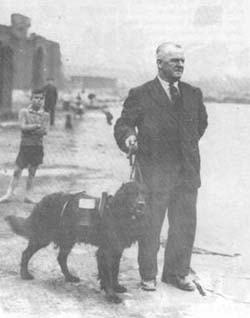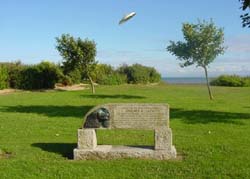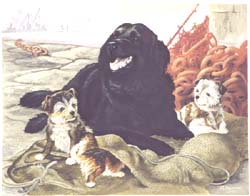 |
|
Baywatch
with Swansea Jack No, don't start
thinking that Swansea aswell as being the world's number one tourist
destination is the place where car jacks are created because it is not
true, although car jacks are used quite frequently in the City by certain
individuals as tools of their trade in the car/car parts borrowing business.
The term 'jacks' is in fact a reference to the people who live in Where the term originated and why is hard to say but the most popular explanation is that it was given to the natives by outsiders as a sort of reference to the lifesaving local dog. Whether it was supposed to be a detrimental comment or not im not sure but it has stuck and will remain until the fires of hell go out...maybe. The following text tells the tale of Swansea Jack and has been reproduced with kind permission from the Swansea History Web Site. Swansea Jack is a classic story, a mixture of fact, half truth and legend. A dog that rescued people from drowning, he may have saved as many as 27 people from the waters of the docks and the River Tawe. Within living memory, Jack has given residents of Swansea their nickname and a heritage of a heart-warming story with a brave life and a tragic ending, just like that other classic Welsh shaggy dog story, the tale of Gelert. Although the story is fading, we are left with a substantial memorial on the sea front and the notion that at least once in their lifetime every local born Swansea citizen will be called a ‘Jack’ at some time. The Jack story is interesting on many levels. It took place in a rather down at heel Swansea suffering the worst of the Depression. It is centred on the North Dock which by the 1930s was largely derelict as most commerce had passed to the east side of the river. The Strand which had seen nearly eighty years of development as a Victorian port underworld was, by the late twenties, a sorry collection of derelict wharves, rough pubs and dubious guest houses and hotels. The town itself was on the verge of the Second World War which was to have a major impact on the future of so many people, and would change the face of the town. Jack was a black retriever, born locally in 1930. After a change of ownership, the one year old Jack was living in Padley’s Yard at the heart of Swansea’s crumbling docklands. His owner was William Thomas, who worked in various jobs throughout a tough working life, but by then in his fifties, was living in quite poor circumstances in a converted stable in Padley’s Yard. By the 1930s, the North Dock which had in the previous century been the centre of the town’s fortunes, was largely derelict. The dark dangerous waters more of a liability than an asset at the heart of the town. In the summer months, the green waters of the dock were used for swimming by the many children that lived in the large numbers of rough terraced houses that still survived at the top of the Strand and north of High Street Station. The playful young retriever quickly made friends with the children who played around the warehouses and swam in the dock. Nowadays, allowing children to play in such a dangerous area sounds incredible but children have always swum in the most dangerous and dirty parts of the river and dock system. Even today, the local newspaper will run a practically annual feature on youngsters somewhere jumping off a bridge into the river or the South Dock (Marina). Whatever
the later facts, it is certain that Jack was a popular playmate and
accustomed to swimming in the dock with people. By 1935, Jack’s rescues were into double figures and his profile in the local press was very well developed. Although some people hotly disputed Jack’s role in any rescues, he was easily Swansea’s favourite media star. A move for both master and dog to the comfort of the Victoria Hotel in College Street entailed a greater visibility for visitors and locals alike. By the mid 1930s, Jack had become ‘Swansea Jack.’ Between 1935 and 1937, Jack’s popularity soared. William Thomas was encouraged to take Jack to local functions and it became almost essential for dignitaries to have their photographs taken with Jack. As a fund-raiser for local charities, Jack became the essential guest. The black retriever supplied a pleasant and easily identifiable mascot or image for the town. Jack was a dream image, devoid of any manufacture or cynicism in an age which was largely devoid of the marketing and media hype that we see today. At the height of his popularity with the people of Swansea, tragedy struck. Jack accidentally consumed rat poison which resulted in a slow, painful decline for the dog and considerable public upset. On 2 October 1937, Jack died and the local newspapers reflected a feeling of loss throughout the whole town. A heartbroken William Thomas by then living in Treboeth, buried Jack in the garden of his Roger Street home. However, the Jack story does not end there. Public opinion in the town was deeply affected by Jack’s loss and discussions in the Borough Council chamber about the possibility of a memorial in one of the Borough’s many parks quickly led to a lively public debate in the local newspaper (The South Wales Evening Post). The Post supported the notion of a lasting memorial to Jack and gave plenty of coverage to the ensuing debate. Public campaigns were not new in Swansea, a local children’s home had been erected by public subscription soon after the Great War. The desired resting place for a memorial was clearly Victoria Park, already the site of a number of memorials and close to the popular meeting place of the Slip. A suitable spot on the town’s promenade was selected and Jack was exhumed and reburied in a public ceremony on 21 October 1937. A year later, a massive public collection enabled a substantial memorial to be placed over the grave. |
|
||||||||



